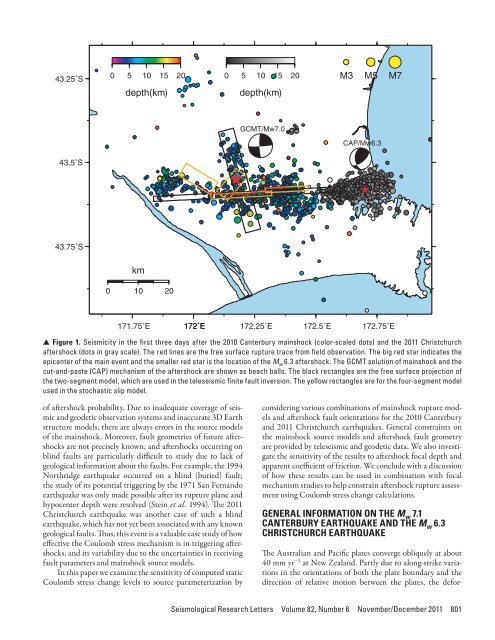Here - Stuff
Here - Stuff
Here - Stuff
You also want an ePaper? Increase the reach of your titles
YUMPU automatically turns print PDFs into web optimized ePapers that Google loves.
43.25˚S0 5 10 15 200 5 10 15 20M3 M5 M7depth(km)depth(km)GCMT/Mw7.0CAP/Mw6.343.5˚S43.75˚Skm0 10 20171.75˚E 172˚E 172.25˚E 172.5˚E 172.75˚E▲ ▲ Figure 1. Seismicity in the first three days after the 2010 Canterbury mainshock (color-scaled dots) and the 2011 Christchurchaftershock (dots in gray scale). The red lines are the free surface rupture trace from field observation. The big red star indicates theepicenter of the main event and the smaller red star is the location of the M w 6.3 aftershock. The GCMT solution of mainshock and thecut-and-paste (CAP) mechanism of the aftershock are shown as beach balls. The black rectangles are the free surface projection ofthe two-segment model, which are used in the teleseismic finite fault inversion. The yellow rectangles are for the four-segment modelused in the stochastic slip model.of aftershock probability. Due to inadequate coverage of seismicand geodetic observation systems and inaccurate 3D Earthstructure models, there are always errors in the source modelsof the mainshock. Moreover, fault geometries of future aftershocksare not precisely known, and aftershocks occurring onblind faults are particularly difficult to study due to lack ofgeological information about the faults. For example, the 1994Northridge earthquake occurred on a blind (buried) fault;the study of its potential triggering by the 1971 San Fernandoearthquake was only made possible after its rupture plane andhypocenter depth were resolved (Stein et al. 1994). The 2011Christchurch earthquake was another case of such a blindearthquake, which has not yet been associated with any knowngeological faults. Thus, this event is a valuable case study of howeffective the Coulomb stress mechanism is in triggering aftershocks,and its variability due to the uncertainties in receivingfault parameters and mainshock source models.In this paper we examine the sensitivity of computed staticCoulomb stress change levels to source parameterization byconsidering various combinations of mainshock rupture modelsand aftershock fault orientations for the 2010 Canterburyand 2011 Christchurch earthquakes. General constraints onthe mainshock source models and aftershock fault geometryare provided by teleseismic and geodetic data. We also investigatethe sensitivity of the results to aftershock focal depth andapparent coefficient of friction. We conclude with a discussionof how these results can be used in combination with focalmechanism studies to help constrain aftershock rupture assessmentusing Coulomb stress change calculations.GENERAL INFORMATION ON THE M w 7.1CANTERBURY EARTHQUAKE AND THE M w 6.3CHRISTCHURCH EARTHQUAKEThe Australian and Pacific plates converge obliquely at about40 mm yr −1 at New Zealand. Partly due to along-strike variationsin the orientations of both the plate boundary and thedirection of relative motion between the plates, the defor-Seismological Research Letters Volume 82, Number 6 November/December 2011 801
















